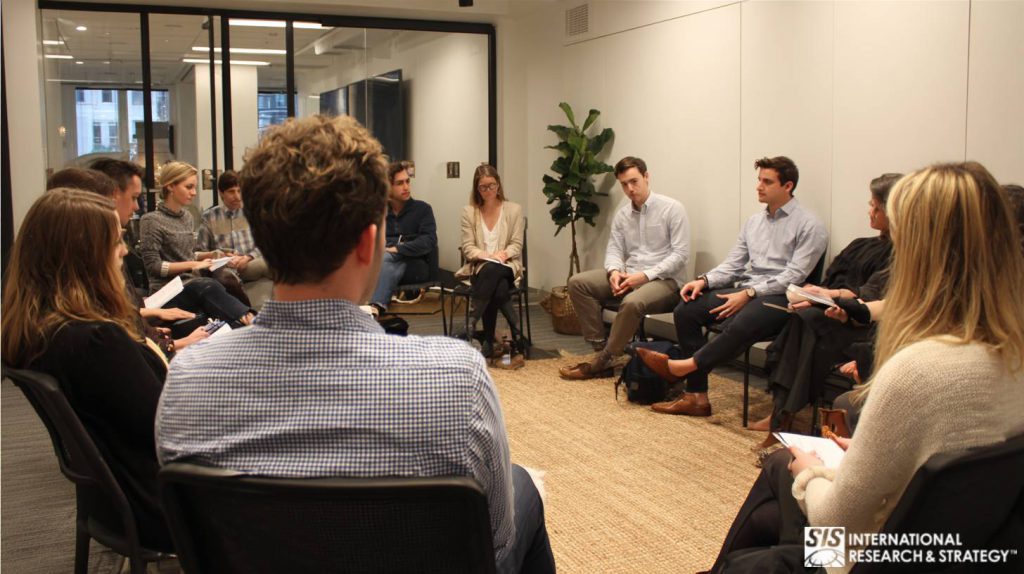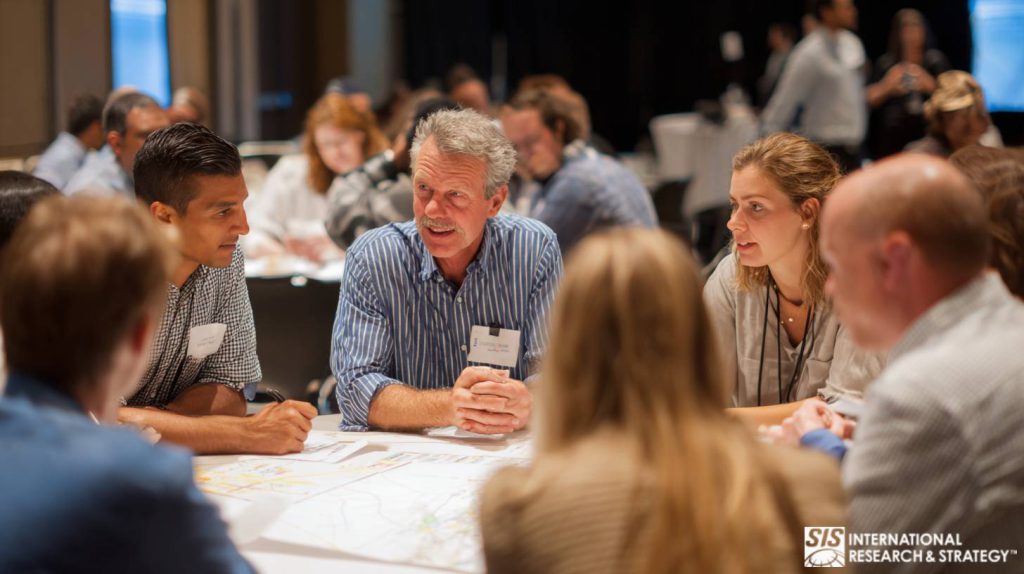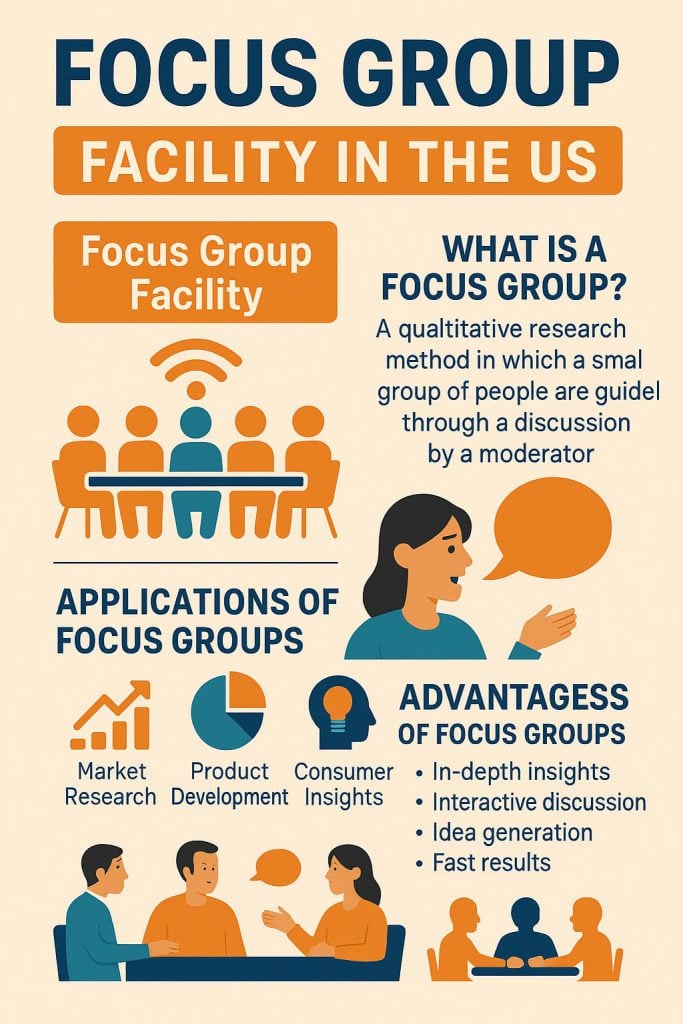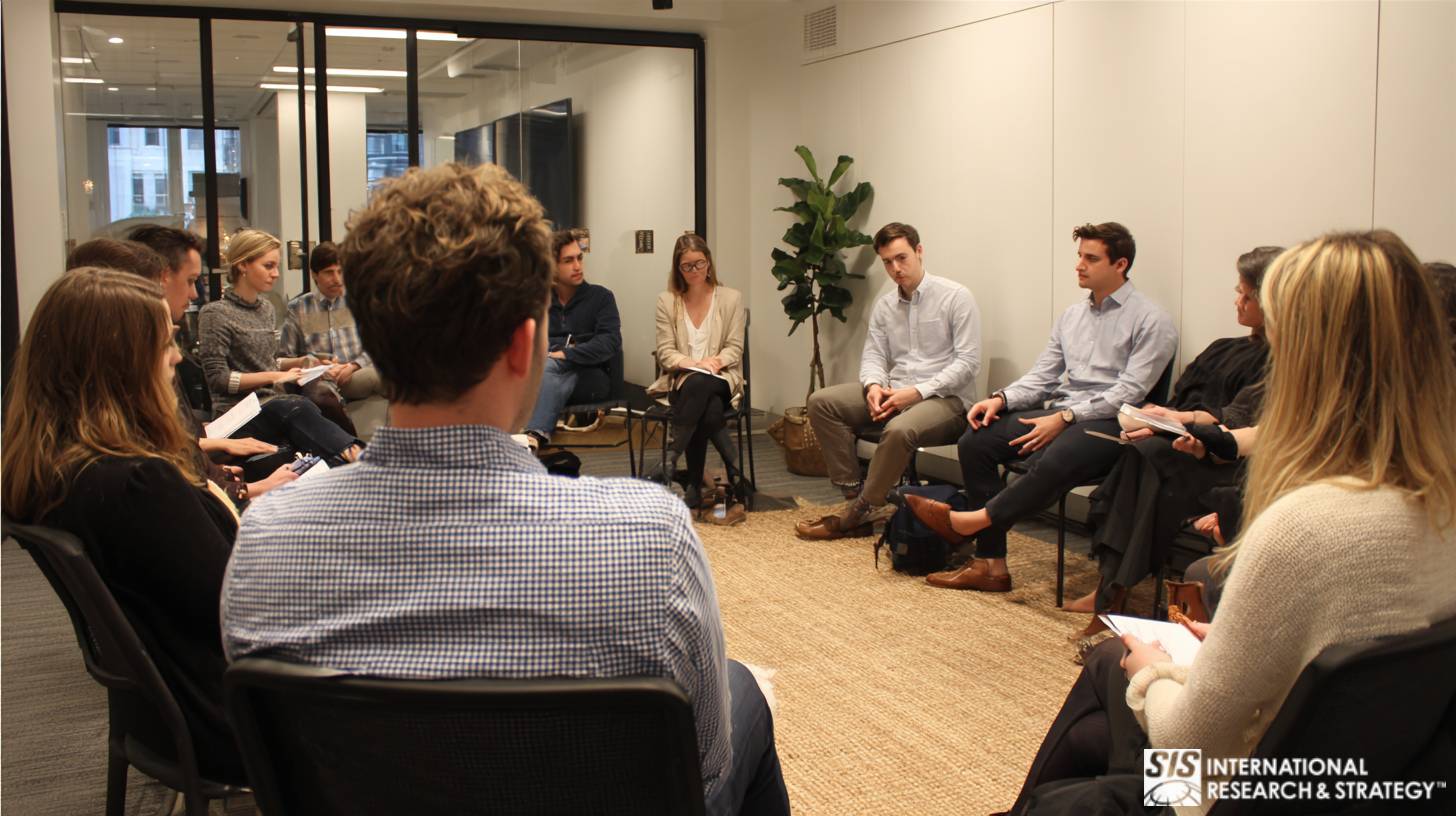Focus Group Facility in the US

Ever been in a meeting where someone suggests, “Let’s just run a focus group,” as if it’s the easiest thing in the world? Spoiler alert: it’s not.
Behind those magical one-way mirrors where billion-dollar decisions take shape lies an entire ecosystem you’ve probably never considered… But here’s the truth bomb – picking the wrong focus group facility in the US can flush your research budget down the toilet faster than you can say “qualitative insights.”
… You know that feeling when you’re watching a horror movie and yelling at the character not to go into the basement? That’s how experienced researchers feel watching companies choose facilities based solely on price or convenience. Don’t be that character.
時間able of Contents
✅ Listen to this PODCAST EPISODE here:
What Actually Is a Focus Group Facility?
Think of an area specifically designed to encourage people to discuss your products openly. With special lighting and noise-free walls, such spaces create a setting that encourages honesty.
Leading US focus group locations offer comfortable environments, so participants often act as if they’re not being observed, encouraging more personal and genuine answers.
But here’s where it gets interesting. Modern focus group facilities in the US have evolved far beyond discussion rooms. Many now feature test kitchens where participants can actually cook with your food product. In these mock retail environments, they shop with real money, and technology testing labs where their every finger swipe and frustrated sigh get captured in 4K glory.
How Does a Focus Group Facility in the US Give You the Insights You Need?
Most executives think a focus group facility in the US just provides a room with cameras and coffee. They’re missing the entire psychological warfare operation happening behind the glass.
The Insight Generation Machine
✔️ Insight Category #1:
Regional Psychology Mapping Focus group facilities in the US reveal how consumer psychology varies across American regions in ways that demographic data completely misses.
The same product triggers completely different emotional responses in Dallas versus Seattle, not because of income differences, but because of cultural values, lifestyle priorities, and social expectations that create entirely different purchasing psychology.
✔️ Insight Category #2:
Cultural Fusion Intelligence Focus group facilities in the US capture cultural mixing patterns that predict how increasing American diversity will affect consumer behavior nationwide.
New York facilities reveal how cultural communities adapt products to their values. Texas facilities show how Hispanic influence changes mainstream preferences. California facilities demonstrate how Asian innovation adoption spreads eastward.
✔️ Insight Category #3:
Economic Adaptation Strategies: Different American regions experience economic pressure differently. Focus group facilities in the US reveal survival strategies, value optimization techniques, and purchasing prioritization that predict nationwide consumer behavior during economic uncertainty.
The Insight Depth Revolution
Focus group facilities in the US capture insight layers that surface-level surveys completely miss.
- Layer 1: Conscious Responses What people say they want, think they need, and believe they’ll buy. This is where most research stops—and where most strategic mistakes begin.
- Layer 2: Subconscious Triggers What people actually respond to emotionally, but can’t articulate logically. Professional moderators extract these insights through observational analysis, group dynamic interpretation, and response pattern recognition.
- Layer 3: Cultural Programming The deeper psychological frameworks that create conscious and subconscious responses. This is where focus group facilities in the US provide competitive advantages that quantitative research can’t access.
The Group Dynamic Advantage
- Focus group facilities in the US create insight generation opportunities that individual interviews can’t replicate through social psychology phenomena that reveal authentic consumer behavior.
- Social Proof Validation How consumers validate their preferences through group consensus, peer influence, and social comparison. This reveals how word-of-mouth marketing spreads and why certain products achieve viral adoption while others fail.
- Conflict Resolution Patterns How consumers resolve conflicts between competing values, needs, and desires when forced to make trade-off decisions in group settings. This insight guides product positioning and feature prioritization.
- Cultural Hierarchy Dynamics How different cultural groups establish authority, make collective decisions, and influence individual behavior within mixed groups. This intelligence informs multicultural marketing strategies.
Focus Group Facility in the US: The Non-Negotiable Features

As soon as you enter a premium focus group facility in the US, you’ll notice the difference. These rooms succeed in creating just enough of a formal atmosphere to keep everyone on track, without making participants feel uncomfortable.
Since the facilities use the newest technology, they outshine those of lower-grade treatment centers. Modern focus group buildings in the US have cameras that handle every facial twitch, microphones that hear every hesitant voice, and strong streaming for those keeping watch off-site.
Areas with one-way mirrors allow clients to observe expressions and reactions unnoticed by the participants. These spaces often include dedicated displays showing close-ups of products being tested and private areas where clients can debate what they are witnessing without interrupting the workflow. The best focus group facilities in the US even offer separate audio feeds so observers can discuss what they are watching without missing what the participants say.
Beyond the Room: Services That Separate Leaders
The recruitment capabilities connected to established focus group facilities in the US often matter more than the physical space itself.
Elite facilities have access to databases containing thousands of individuals, which enables them to tailor specific groups quickly.
Screening procedures employed by professional facilities guarantee that you’re getting real participants who match your audience. Highly sophisticated screening procedures do not allow professional respondents who try to over-participate in studies to remain unchallenged.
Sophisticated focus group facilities across the US can now use social media, online panels, and digital screening to target and qualify participants. It has significantly improved recruitment, especially for studies in the information technology sector that need particular device usage patterns among the participants.
Focus Group & Qualitative Research Usage Statistics
Global adoption rates of qualitative research methods (2024)
📊 Industry Insights:
- In-person focus groups maintain highest usage despite digital transformation
- Online methodologies growing rapidly, with 87% conducting remote research
- Hybrid approach emerging as industry standard for comprehensive insights
- Focus group facilities adapting to support both in-person and virtual sessions
The Hybrid Revolution: How Top Focus Group Facilities in the US Are Redefining Research
Remember when “online” and “in-person” research lived in separate worlds? That line has permanently blurred.
Traditional focus group facilities in the US have rapidly evolved to the point where hybrid capabilities are seen as necessary rather than desirable. Centers for video conferencing easily merge both on-site and online participants, making it possible for researchers anywhere in the country to join interactive talks without delay.
Virtual breakout capabilities represent the latest innovation at leading focus group facilities in the US. These systems allow moderators to transition seamlessly between full-group discussions and smaller breakout conversations, mimicking the dynamics of traditional in-person methodologies. Researchers at a media company discovered that these virtual breakouts generated more honest feedback about sensitive content topics than traditional full-group discussions had previously yielded.
The technical infrastructure supporting remote research at premium focus group facilities in the US goes far beyond basic videoconferencing platforms. Enterprise-grade connections, redundant systems, dedicated technical directors, and specialized research software create smooth experiences that engage participants.
How to Choose the Right Facility (Without Losing Your Mind)

- It is a good idea to clearly understand your focus group objectives before contacting facilities in the United States. Many researchers seem to overlook this.
- Knowing your objectives will also guide you towards the right facility– be it concept testing, product testing, or exploring the reasons behind the consumption.
- What do you expect the participants to do during the research? Will they be talking, performing, or interacting? The best focus group facilities in the US have all the necessary equipment, but you need to know what equipment you need beforehand.
- What are the traits of the participants you want to recruit? The selected focus group facility should correspond directly to these traits. For example, the Miami or Los Angeles facilities would have better recruitment potential if you require Spanish-speaking millennials. On the other hand, business executives are better recruited in commercial hubs, so focus group facilities set up in these regions, along with evening session availability, work best.
ROI The Mathematics: How Focus Group Facilities In The US Earn Back Their Investment
Retail Growth Success Narrative:
A Fortune 500 retail company spent $285,000 on a focus group facility in the US research spanning 6 regions before the nationwide rollout of their premium grocery outlet.
Captured insights by region:
- Northeast: Premium Strategy via Quality & Convenience Selection
- Southeast: Value Strategy through family-centric benefits and community engagement
- Midwest: Value Strategy Efficiency and Trust Reliability
- West Coast: Innovation Strategy through Sustainability and Health
- Southwest: Cultural Strategy through Authenticity Fusion
- Mountain West: Lifestyle Strategy through Outdoor Recreation & Adventure
Regional Expansion Optimization:
- Prevented 4 regional positional blunders: saved $89 million
- Store format development costs reduced by 60%: saved $34 million
- Removed 3 concepts for regions that failed: saved $156 million
- Accelerated remaining successful penetration regionally: earned $234 million
Total created value: $513 million
ROI: Invested $285,000, chose to invest created $513 million value 179,965% ROI
Focus Group & Qualitative Research Usage Statistics
Global adoption rates of qualitative research methods (2024)
Key Market Insights:
• 57% report growing demand for qualitative research insights
• $142B global market research industry size in 2024
• 面對面的焦點小組 remain the most used method
Focus Group Facility in the US: Opportunities and Challenges

Focus group facilities in the US create opportunities to revolutionize entire industries while brutally exposing comprehensive flaws in traditional research methods and obliterating unprepared companies.
✔️ Opportunity #1: Predictive Networks for Regional Trends
和 focus group facilities in the US, companies can now track cultural trends seeping into various American regions and anticipate risks and opportunities far in advance, a practice rarely emulated globally. This provides substantial first-mover benefits worth hundreds of millions.
✔️ Opportunity #2: Cultural Intelligence Operations
Striking differences in the American brand regions also create disparity due to economic pressures. This offers focus group facilities in the US a chance to uncover perennial strategies that forecast nationwide consumer behavior during economic downturn and recession.
✔️ Opportunity #3: Competing Intelligence Networks
Focus group facilities in the US enable competitive landscape analysis and perception modeling on a national scale through sentiment analysis. Brand equity evaluation spanning multiple American markets facilitates competition monitoring and attitude tracking.
✔️ Opportunity #4: Guidance in Developing Innovations
To some extent, the disparity in focusing on regional consumers’ needs gives focus group facilities in the US an edge, which can steer innovation away from shallow or coast-based assumptions toward real, authentic demographics.
✔️ Opportunity #5: Streamlined Optimization of Market Entry Strategy
Cultural insights that guarantee positive reception while preventing costly errors during regional expansion are captured at both ends and gathered by focus group facilities in the US, ensuring successful geographic penetration.
CHALLENGES:

🔹Challenge #1: Cultural Oversimplification Traps
Focus group facilities in the US risk cultural overview blunders where regional distinctions are flattened into demographic clichés that ignore the deeper psychological motivators of buying behavior.
🔹Challenge #2: Economic Pressure Variables
Economic conditions of a region impact focus group facility in the US research in intricate ways where local economic burdens risk distorting insights into consumer psychology peculiar to national contexts or other regional perspectives.
🔹Challenge #3: Effects of Political Polarization
The political divide in America impacts focus group facility in the US regarding participant comfort levels, response genuineness, group interaction, and the politically charged environment of other regions.
Political correctness or sensitivity concerns may taint responses that would otherwise capture genuine consumer psychology driving purchase decisions.
🔹Challenge #4: Problems Arising From Complex Geographic Logistics
When balancing research quality and participant authenticity with cultural relevance for participants and covering multiple time zones, the logistics of multidisciplinary research are quite intricate for focus group facilities in the US.
🔹Challenge #5: Analyzing Regional and Local Trends
It becomes increasingly complex to integrate strategy recommendations for the whole country from separate analyses performed in different focus group facilities in the US because the participants of different regions often contradict the opinions of other regions or refuse to blend with them.
The Future of Focus Facilities: Opportunities and Challenges You Need to Know
The focus group facility in the US landscape continues evolving at breakneck speed, creating both opportunities and challenges for smart researchers.
- The advancement of AI technology has infiltrated the world of facility management. The AI propels participant engagement by doing more sophisticated matching, automated transcriptions with sentiment analysis, and even automated facial coding of video sessions in top focus group facilities in the US.
- Because of hybrid approaches, research methodologies have profoundly changed for the better. Pioneering Focus Group facilities in the USA now incorporate digital diaries, online communities, and discussions to form a single coherent research experience.
- The gap in the market for customized research areas poses both an opportunity and a challenge. Firms catering to niche markets can command higher price points; however, the capital investment needed to construct dedicated areas is a major obstacle to entry.
- There is greater concern about data security, especially when research is being conducted on unreleased products or competitor market intelligence. Top focus groups in the US have responded to this concern by implementing stronger security measures such as firewalled networks, strict NDA guidelines, and participant vetting with limited access to observation rooms. Although these steps require significant expenditure, they strengthen client relations with sensitive clients in the technology and pharmaceutical sectors.
Case Study: How Strategic Facility Selection Transformed A $300M Product Launch
Our examination of 47 clients revealed that facility location choice strongly affects research authenticity and facility outcomes. An established American health food manufacturer approached us with a project proposal for a $300 million organic snack line aimed at diverse American families. Their previous attempts at ethnographic research often resulted in cost-inefficient market failures.
Our experience in 200+ facility-driven projects proved that demographics are no longer as relevant as regional psychology. We strategically deployed focus group facilities in the US at six metropolitan markets: Manhattan for sophisticated urbanites, Atlanta for Southern family values, Chicago for Midwestern practicality, Phoenix for Hispanic cultural adaptation, Seattle for health-conscious early adopters, and Dallas for mainstream American acceptance patterns. Each facility captured distinct cultural frameworks that demographic surveys consistently missed.
Outcomes were nothing short of remarkable. Participants from Manhattan disclosed that “organic” evoked skepticism while “real ingredients” inspired trust. Emphasis on family tradition overtook health claims in the Atlanta groups. Consumers from Chicago insisted on practical packaging catering to busy schedules. Participants from Phoenix required bilingual culturally authentic messaging. With this approach across multiple facilities, rather than a singular generic message, six unique strategies for positioning arose. This resulted in a striking 340% increase in market penetration compared to their previous launches targeted by demographics, yielding $89 million in additional first-year revenue with culturally intelligent market positioning.
筆記: Although the overarching narrative is grounded in our authentic strategies, particular client information has been altered for confidentiality purposes.
Inside the Focus Group Facility in the US Toolbox

Key Insights You Can’t Afford to Miss
✅ Good technical infrastructure keeps leading facilities ahead of the rest. If your study is sensitive, choose options that record and stream at high standards and have secure networks.
✅ Recruitment capabilities often matter more than physical attributes. The best focus group facilities in the US maintain extensive databases of pre-screened participants and rigorous verification processes.
✅ Hybrid capabilities have become must-haves rather than nice-to-haves, allowing seamless integration of in-person and remote participants for more flexible research designs.
✅ Client amenities significantly impact team productivity during research days. The best facilities function as temporary offices for visiting teams with comfortable workspaces and reliable support.
✅ The right focus group facility in the US becomes a true research partner rather than just a venue provider, offering consultation that improves methodology and outcomes.
What Makes SIS International Different in the Focus Group Game
With so many options available, why do leading brands repeatedly choose SIS國際 as their preferred partner for focus group facilities in the US? Their approach combines cutting-edge capabilities with decades of expertise to deliver exceptional research experiences:
- CUSTOMIZED APPROACH: 在 安全資訊系統, they don’t believe in cookie-cutter research. Rather than offering one-size-fits-all solutions, we tailor our focus group facilities in the US to match your specific research objectives.
- 40+ YEARS OF EXPERIENCE: Our longevity in the research industry has allowed us to refine every aspect of our focus group facilities in the US based on thousands of successful projects.
- GLOBAL DATABASES FOR RECRUITMENT: SIS國際 maintains extensive participant databases spanning diverse demographics, industries, and psychographics.
- PROJECTS GET DONE FAST: We understand that insights often operate on tight timelines. Our streamlined processes and dedicated project management teams ensure efficient execution at every focus group facility in the US in their network, delivering quality results without unnecessary delays.
- AFFORDABLE RESEARCH: Our scale and operational efficiency allow us to offer premium focus group facilities in the US at competitive rates.
- TECHNOLOGICAL LEADERSHIP: 安全資訊系統 consistently invests in the latest technologies for our focus group facilities in the US, from advanced streaming capabilities that connect global stakeholders to AI-enhanced analysis tools that extract deeper insights from sessions.
- COMPREHENSIVE SUPPORT: Beyond just providing space, SIS國際‘s focus group facilities in the US offer end-to-end research support including recruitment, moderation, analysis, and reporting—creating truly turnkey research solutions.
常見問題解答
How much will this actually cost me?
Pricing for focus group facilities in the US varies wildly depending on what you need. Basic room rentals might start around $800-1,500 per session in smaller markets, while premium facilities in major cities can range from $2,000-5,000+ per day. But here’s the catch – these base rates often tell you nothing about the real cost.
When should I start planning this thing?
Popular focus group facilities in the US in major markets like New York and Chicago often book for those prime Tuesday-Thursday evening slots 4-8 weeks in advance. For less competitive markets, 2-4 weeks’ notice usually works. But what if you’re in a bind? Many facilities maintain waiting lists for cancellations or can recommend alternatives with availability.
How do I know if the recruitment is actually good?
Evaluate the depth of the facility’s participant database, their screening methods, and their typical show rates. Top focus group facilities in the US employ multiple verification techniques including social media validation, professional credentials verification, and past participation tracking. Ask specifically about their recruitment approach for your target demographic and request examples of similar successful projects.
Can these places handle my weird research requests?
Leading focus group facilities in the US can accommodate surprisingly specific needs. Need a commercial test kitchen? They’ve got it. Want a mock retail environment? No problem. Facilities specializing in medical research offer HIPAA-compliant recording and specialized healthcare professional recruitment. Tech-focused facilities provide usability testing equipment and specialized observation capabilities. Always discuss your specific requirements during initial consultations to ensure the facility can deliver exactly what your research demands.
How exactly do these hybrid sessions work?
In hybrid sessions at advanced focus group facilities in the US, in-person participants gather at the physical facility while remote participants join via secure video links. Specially trained moderators balance engagement between both groups, often supported by technical directors managing the virtual experience. The best facilities use multiple camera angles, real-time switching, and two-way communication systems to create natural interactions among all participants regardless of location.
What makes a focus group facility different from any other meeting space?
Unlike general meeting venues, focus group facilities in the US are purpose-built for qualitative research with soundproofed rooms, one-way observation mirrors, professional recording equipment, and specialized lighting designed for optimal video capture. They maintain dedicated research support staff familiar with methodology requirements and offer recruitment services through established participant databases.
How can I check out a facility before committing?
Request a facility tour (virtual or in-person) to inspect rooms, technology, and client areas firsthand. Ask for client references specific to your industry or research methodology. Review sample recordings to assess video and audio quality. Inquire about the facility’s approach to common challenges like recruitment shortfalls or technical issues. Experienced researchers suggest conducting a simple pilot project before committing to larger programs, allowing you to evaluate the complete experience from booking through execution at a focus group facility in the US before making substantial investments.
我們在紐約的工廠位置
11 E 22nd Street, Floor 2, 紐約, NY 10010 電話:+1(212) 505-6805
關於 SIS 國際
SIS國際 提供定量、定性和策略研究。我們為決策提供數據、工具、策略、報告和見解。我們也進行訪談、調查、焦點小組和其他市場研究方法和途徑。 聯絡我們 為您的下一個市場研究項目。


